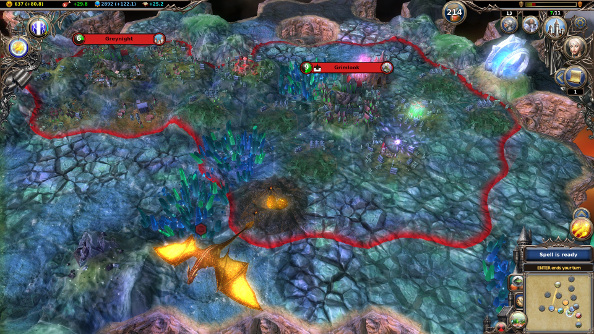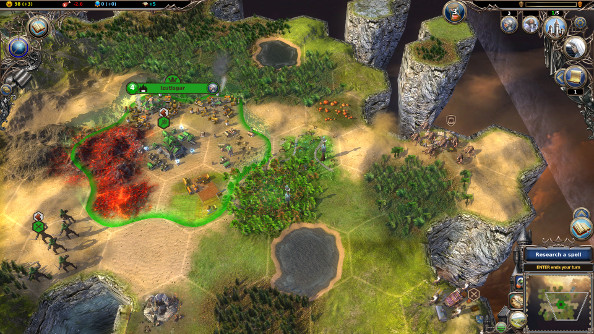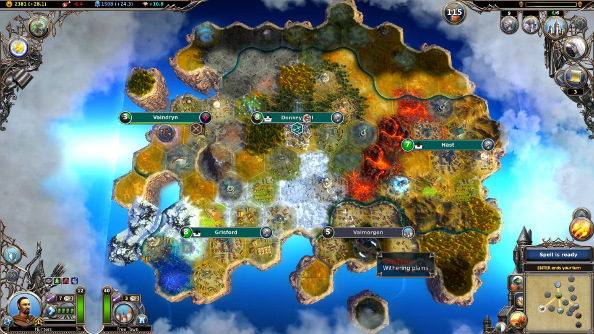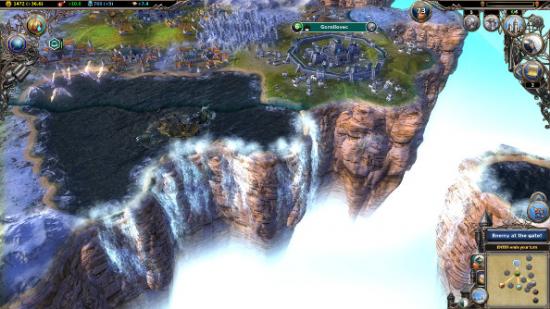After I finally killed the nettlesome troll who tried to extort cash from my kingdom in order to use the cross-dimensional portal, my army arrived in a forest straight out of The Lion, the Witch, and the Wardrobe. Cautiously, my axemen moved forward through the ice-encrusted trees while my archers, veterans of a dozen battles, advanced in support.
Everything seemed safe. There were a few giant bears and wolf packs, but I dispatched them easily. “Warlock has changed,” I thought. “This used to be murderously difficult.”
Then my scouts ran into a pair of ice queens who killed my entire army in a single turn, and dragons appeared back in my undefended home dimension and started laying waste to my cities. Warlock 2: The Exiled might be a refined and improved version of its predecessor, it still knows how to throw a sucker punch.
Warlock bears a lot of superficial resemblances to Civilization V, but it’s actually much closer to Master of Magic than the latest incarnation of Firaxis’ strategy franchise. This is all to the good: fantasy strategy games tend to be ill-served by aping standard 4X games, with their intricate economies and tech trees. Warlock keeps things relatively simple. Cities level with their population growth, which lets them add new buildings. You can almost think of the cities themselves as immobile player-characters.
Technology is a function of development. A fantasy world can’t reasonably go from longbowmen to stealth jetfighters, but it’s silly to pretend that some huge technological leap forward is required to build axemen. So research is solely directed toward news spells, while unit tech depends on what a city is capable of building via its upgrades.
The result may not be as deep as fans of Civ or Europa Universalis prefer, but for me it finds that sweet spot that Heroes of Might and Magic had at its best. The focus is more on tactical warfare and exploration than empire management; your cities and resources exist to support that end. That also means that Warlock is the rare fantasy 4X that actually feels like the RPG experiences that inspire it. Pushing back the boundaries of the unknown is full of menace and dread, and even the most powerful army can still be blindsided by the appearance of a terrifying monster.

It took Warlock 2 to bring all this to life, however. Warlock 2: The Exiled is built on a fascinating conceit: each world is connected to several others, and in each one there is a full 4X map defined by a different, menacing characteristic. A portal might dump you on a distant moon filled with death robots, or in an endless desert, or a magic-blasted wasteland. Each world is filled with its own kind of terrain and native creatures, and you never know exactly what you’ll run into. Eventually, as you colonize different realms, your empire will span not just continents but also dimensions.
The original Warlock had all these ideas, but not the game design to support them. The difficulty spike was too great as you left the “normal” fantasy world of Aradania and entered the other dimensions. Every other strategy writer I talked to had the same experience: the other realms were cool and exciting, but they were so punishing that it rarely made strategic sense to go make use of them. It was more effective to focus on winning the very basic 4X game on the main world. Otherwise you’d lose the game while you armies were trying to storm the astral plane, and some damned rat king just rolled up with a few ships and soldiers and started taking down other players.

Warlock 2 finds the design that brings all its ideas together. The difficulty curve seems more appropriate as you hop realms, and it de-emphasizes empire management in favor of exploration and warfare. For the core game, they’ve also given the different realms an important new role. Now, instead of starting every player on the same map and just hoping they’ll go explore the rest of the game, they are seeded across the different dimensions. The overall goal for each side is to battle their way back from their trans-dimensional exile and retake Aradania from the powerful mage who has seized control.
It’s a change with sweeping ramifications. Instead of just building up cities and fighting wars, Warlock 2 becomes about protecting your position across completely different worlds, and jealously guarding your connections to the portals. Other empires are still competitors, but the competition is less zero-sum at the start. Coming across another ruler is slightly less threatening when you’re both fighting to keep a toehold in a world overrun with rogue mages and giants who can swat down entire armies in one blow.
Since Warlock 2 starts imposing penalties if your empire gets too large, it also keeps the managerial workload to a reasonable level. It still pays to set up lots of cities as you need them, but when their job is done, you can convert them to “special cities” that effectively set them up as AI allies. They can still play important roles, providing economic support or acting as a super-fortification to lock down a vital area. But your attention can move on to more important cities in new areas.
I’ve never seen a game that so nicely splits the difference between fantasy and strategy. Cities can function as important new jumping-off points for armies and heroes, but as they expand they become increasingly vulnerable as their borders get more exposed. Protecting a stronghold that’s beset by monsters, neutral cities, and enemy empires feels like an extended encounter where the city is as much a character and resource as your troops. Since new buildings get increasingly hard to come by, the decision between building a magical weapons emplacement or a farm that will benefit the city in the long-term is a momentous one. You have the option to revise your cities at a later date, but you pay for it in “unrest”, so it’s best to plan in advance.

The main campaign focuses on the different factions’ campaign to march through the different worlds and reclaim their homeland, but a more open-ended sandbox campaign will also be available. There will also be some kind of co-op PvE mode, and this is probably the only 4X where I can actually see such a thing working well.
I’m also less certain of how good the traditional 4X game mode will be. So much of the experience I had with Warlock 2 was driven by the pacing imposed by the story. Each new world had to be explored and tamed, and there was strong pushback at regular intervals from the story’s main villain. But that leaves me with no idea of what to expect in an open-ended campaign, especially when the worlds are almost fully occupied by factions and most of the AI monsters have been exterminated. What makes Warlock 2 such a satisfying genre blend might hamstring it in the late game.
Still, it may not need to be more than a game about adventuring and exploring. It’s a big world with lots of dangers, and I can easily see myself coming back to that campaign across several playthroughs. I’m especially excited about the co-op PvE mode, which should increase the feeling of being in a true role-playing game, though no details are available at this time. We’ll find out all the answers soon enough, however: Warlock 2 is due out in April. That’s good news, because I went from being lukewarm on Warlock 1 to having Warlock 2 become the most exciting thing I saw at Paradox Con, and something I cannot play soon enough.
